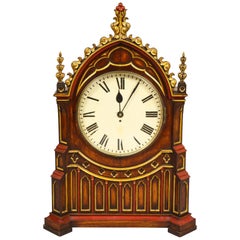Gothic Fusee Clock
Antique Mid-19th Century English Gothic Revival Mantel Clocks
Oak
People Also Browsed
Antique Late 18th Century Italian Louis XV Sofas
Wood
Mid-20th Century American Mid-Century Modern Sofas
Upholstery, Wood
Antique Early 1900s French Louis XVI Commodes and Chests of Drawers
Marble, Ormolu
21st Century and Contemporary American Modern Console Tables
Brass
Vintage 1950s American Mid-Century Modern Slipper Chairs
Iron
Antique Mid-19th Century Italian Empire Sofas
Fabric, Walnut
Antique Late 19th Century Gothic Revival Chairs
Oak
Antique 19th Century Persian Sultanabad Persian Rugs
Wool
Antique Late 19th Century Persian Sultanabad Persian Rugs
Wool
Antique 19th Century English Other Tables
Mahogany
Vintage 1960s French Mid-Century Modern Lounge Chairs
Fiberglass
Antique Mid-19th Century French Renaissance Revival Mantel Clocks
Marble, Bronze
Antique Late 19th Century French Louis Philippe Armchairs
Walnut
Early 20th Century French Art Nouveau Side Tables
Mahogany
Antique Early 1900s British Arts and Crafts Bookcases
Copper
Antique Late 19th Century Persian Art Nouveau Persian Rugs
Wool
A Close Look at Gothic-revival Furniture
The Gothic Revival movement (also called Victorian Gothic or Neo-Gothic) emerged in Britain in the 1740s, and reached its height in the late-19th century. Gothic Revival furniture's characteristics include such decorative flourishes as pointed arches, floral details, finials, heraldic motifs and linenfold carving.
The movement was rooted in religious and social conservatism. Gothic Revival's proponents, who included Charles Barry and A.W.N. Pugin, the architects of London’s Houses of Parliament (designed in 1840), believed that the art and architecture of the Middle Ages were authentically spiritual and inherently moral.
In the United States, the Gothic Revival movement shaped both public buildings and private houses. Numerous American schools were built in the early-19th century in a style now called Collegiate Gothic. Many builders and craftsmen were inspired by Andrew Jackson Downing’s widely read 1850 book Architecture for Country Houses, which posited that a family’s home should exemplify their values — and that the Gothic Revival style was particularly well-suited to scholars and clergymen. Furniture with detailing that mirrored that of Gothic Revival buildings appeared in the same period. Such pieces typically feature dark, intricately carved wood, and upholstery in velvet or leather.
Much like the castles or cathedrals that inspired them, Gothic Revival chairs, bookcases and beds make a bold design statement. And while you probably don’t have to cross a moat or raise a portcullis to get through your front door, a Gothic Revival piece will declare that your home is indeed your castle.
Finding the Right Mantel-clocks for You
Personal time-telling devices may have migrated from our pockets to our wrists and finally onto our phones, but despite the convenience of a handheld digital timekeeper, nothing can beat well-made vintage, new and antique mantel clocks.
Invented by clockmakers in France and popularized in the 18th and 19th centuries, these practical yet ornate pieces were typically displayed on top of fireplaces or desks. While the most common mantel clocks were created in the traditional tambour style, which features a wide base that flares into an upright drum- or camelback-shaped case, modern clockmakers and furniture designers have experimented with their own ideas for these decorative objects over the years, introducing different forms and working with unconventional materials. A collection of whimsical, monochromatic handmade mantel clocks crafted by Dutch designer Kiki van Eijk, called Floating Frames, for example, features minimalist frames of anodized wire and ceramic clockfaces.
When shopping for an antique, vintage or new mantel clock, don’t be afraid to branch out. Wood mantel clocks of any era will bring a classic, elegant allure to the shelving in your living room or the bookcase in your bedroom, while Empire-style mantel clocks will comparatively boast eye-catching gilt bronze and pronounced sculptural attributes. Some Art Deco mantel clocks will feature an integration of marble or glass and will likely be marked by the decorative embellishments associated with that particular furniture style.
There’s just something about cool clocks, right? Spend your time with an extraordinary collection of mantel clocks on 1stDibs today.
- 1stDibs ExpertApril 5, 2022A fusee clock uses a mainspring barrel, a fusee and a chain coiled around an arbor. The barrel pulls at the chain, winding the fusee. This pulley method was considered revolutionary at the time, but its mechanical origins can be traced back to the 1600s. This type of watch movement faded out of favor in the mid 1700s. Shop a collection of properly vetted fusee clocks from some of the world’s top sellers on 1stDibs.
- How do you set a fusee clock?1 Answer1stDibs ExpertApril 5, 2022A fusee clock uses a wound cord or chain around a spindle with a pulley to keep time with a symmetrical tick and tock. To wind a fusee clock, a key is needed to unwind the chain off the barrel and back onto the fusee. Moving the hands to the correct time prior to winding is no trick, so setting the time is fairly easy—it’s setting the gears or winding that can be difficult to get just right. Shop a collection of fusee clocks from some of the world’s top sellers on 1stDibs.
